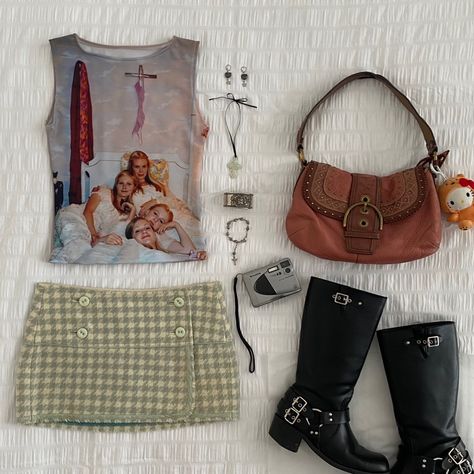
In sixth grade, while I didn’t have much of an idea what I was doing or how to execute it, I wanted to achieve the alternative style that flourished under the heat of the pandemic.
In seventh grade, I tried to achieve the neon, oversaturated, and cartoon-heavy air of the indie teenagers whose content crowded my Pinterest feed. Complete with a fixation on Care Bears, I was knee-deep in the world of animated flowers, skateboards, and sweater vests.
During my eighth grade year, my affinity for indie fashion waned, replaced by a fascination with all things coquette and hyper-feminine. Mixed with the separate—but adjacent—influences of Twilight and the academia look, I bought my first trusty pair of low-waisted jeans and cozy sweaters.
That summer brought an amalgamation of various styles to my wardrobe because, inexcusably, I didn’t know which premade image I wanted to replicate. Fortunately for my indecision, come fall, the Downtown Girl (not to be confused with the Uptown Girl) became an elusive, bookish character on the internet. Always dressed in muted, autumnal tones and Stars Hollow-inspired outfits, the Pinterest character became the latest influence in my closet.
This cycle of consistently trying to reinvent myself and my closet each season persisted for four years.
While I enjoyed all the styles I adopted (to an extent), the clothing I’ve chosen to wear over the years has been clearly influenced by trends. However, this compulsion wasn’t necessarily in the sense that I felt compelled to purchase the most in-vogue pieces of clothing. More so, it was the inevitable, cyclical pressure to embody a new aesthetic that had a chokehold on me.
This normality of recurring self-reinvention is, unfortunately, pushed on the internet at a swift rate. New sub-genres of already niche styles seem to pop up daily, creating more and more specific personas that consumers are heavily encouraged to comply with. Specifically, this impacts the more impressionable and internet-conscious young people.
The issue isn’t necessarily that everyone is being pushed to conform to the same aesthetic. More so, many feel pressured to pick one of the multitude of ultra-precise, idealistic styles and stick to it religiously. Further, this supports the rapid cycle of trends and implications that, if not made up of currently popular clothes, an outfit is outdated.
For me, this meant that pleated, plaid skirts—a longtime favorite fashion staple—suddenly felt too “2020.” And, in 2024, wearing something that was popular in 2020 would be virtually unthinkable, right? Similarly, why would I want to wear form-fitting Y2K graphic long sleeves after their 2021 popularity surge waned? What was even the point of liking leg-warmers if they weren’t considered the newly revived accessories they were a year ago?
Recently, the pressure to reinvent myself periodically left me asking myself what my next aesthetic would be—virtually every style that had appealed to me I had already done before.
As I shifted from look to look, I came to the seemingly obvious conclusion that it shouldn’t matter if a certain trend is out of fashion. If it’s one I love, why shouldn’t I continue to enjoy it perpetually?
And so, more than I ever had before, I began to develop my own personal aesthetic, independent of current clothing crazes. This included clothing that had been deemed out of the ever-changing rotation of stylishness. My wardrobe evolved to be composed of the best elements of the many aesthetics I’d worn over the years.
While driven by the fatigue of constantly hunting for a new look, this change was powered by the realization that not every fashion style is one that genuinely felt like me. Constantly replicating styles unspecific to myself, most aesthetics felt impersonal—like costumes.
Naturally, every aesthetic I tried to replicate contained elements I didn’t particularly enjoy in the first place. For example, those indie mushroom designs and the avant basic patterns of 2021? Extremely unappealing to me. Hawaiian floral printed tank tops popular during the summertime? Not my thing. Adidas Sambas? Nope, not shoes I need to purchase.
Yet, at the same time, the white, yeti-looking Demonia Camel-311 boots will remain on my wish list for the third year in a row, with me not being able to justify purchasing the extravagant item. The same goes for the controversial knee-high Converse and Twilight T-shirts, which have been included in particular aesthetics from years past.
And, as for my closet, that means that my trusty H&M skirt from a four-year-old collection will stay. My old-man argyle sweater will remain to complement the denim mini-skirts I thrifted in 2022. The only perfectly-fitting pair of jeans I have ever found, those too, will remain to see their fourth winter of being worn biweekly.
Even though items I wear regularly have gone in and out of trend, the clothing I wear suits me better than any premade, cookie-cutter style has yet to.
With the continued prevalence of TikTok, Instagram, and Pinterest, new aesthetics are constantly shoved down our throats. As businesses rush to drum up enthusiasm for their products and influencers look to stay relevant while simultaneously making money, the monstrous trend cycles continue their downhill roll, constantly gaining speed.
This fast-moving spiral pulls us, as consumers, into its mania. The pressure of reinvention and to never be dressed out of fashion is omnipresent. Think of the negative connotation associated with wearing the same outfit in two Instagram posts. Or, the fact that there are many memorable clothing items that have risen and fallen in popularity so quickly that they can be painfully associated with certain, specific timeframes (ex., that sequined strawberry dress or the green House of Sunny midi dress).
Thankfully, we are seeing the rise of more de-influencers—creators that encourage slow consumption. Still, there’s undoubtedly a way to go to lessening both pressures to conform to specific aesthetics and to purchase new wardrobes seasonally. Particularly important for the younger and more impressionable generations is finding personal aesthetics—not those the internet forces upon us—integral.



























































































